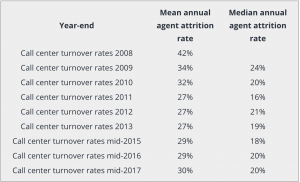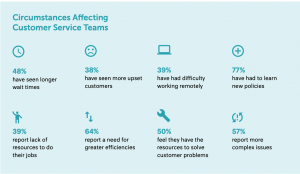Oh, the year 2020…It will definitely go into history books as…well, something.

Between the pandemic, natural disasters, election year in the United States, and so, so much more, there is probably not a human in the world who did not feel extra stress during this difficult year.
For those who already had stressful jobs, recent events did not help. Among those are customer service agents. Customer service industry has always had a high burnout rate and high attrition rate.

Source: ContactBabel
The World Health Organization has an official definition of employee burnout.
Employee burnout is a “syndrome conceptualized as resulting from chronic workplace stress that has not been successfully managed.” (International Classification of Diseases (ICD-11))
The symptoms of burnout include feelings of exhaustion or lack of energy, feelings of negativity or cynicism related to the workplace, feeling of increased mental distance from one’s job, and reduced efficiency in the workplace. (CustomerThink)
What is the primary cause of customer service burnout?
During the pandemic customer service agent burnout could become a more common occurrence due to additional stress both customers and agents have in their lives. Moving to remote work, encountering unusual circumstances due to unprecedented pandemic, and additional emotional tensions all might make customer service burnout a more frequent occurrence. If the burnout goes unaddressed, contact centers can face the risk of losing agents amidst pandemic. They will then have to spend more efforts and funds to rehire, retrain, and re-engage new agents.
How can customer service agents and their managers handle the burnout and remain engaged in their jobs during the pandemic and beyond? By recognizing and addressing the challenges agents face.
Challenge #1: Remote Employees
One of the most dramatic changes in the workforce that occurred during the pandemic is the move to remote workforce. More companies than ever embraced work-from-home practice.
In 2018, 56% of companies worldwide allowed their employees to work remotely at least some of the time. (OwlLabs) During the 2020 pandemic 88% of companies worldwide encouraged or made mandatory for their employees to work from home. (Review42).
While the pandemic force-started this trend there is evidence that remote work is here to stay. In fact, “a survey of business leaders found that 82% plan to maintain a partial work-from-home structure even after COVID-19 is no longer a threat.”(TechRepublic)
For contact center managers leading their newly remote teams presents a special set of challenges. They now have to manage large teams, whose members are working from various locations. In addition to day-to-day managing, employers now must hire, onboard, train, and maintain new employees.
There are certain tactics that, if implemented effectively, can help prevent customer service agent burnout. That, in addition to improving overall functionality of a contact center. These tactics include gamification, professional development, and making wise hiring decisions using right HR software. Additionally, providing autonomy, ditching the scripts, getting the right tools, measuring KPIs, and motivating employees are all essential practices for contact centers that now operate remotely. To learn more, check out our recent article, Best Practices for Remote Contact Centers in 2020.
Challenge #2: Unusual circumstances
There is no doubt that the pandemic is affecting customer service operations in unprecedented ways. According to one report 79% of customer service organizations reported a significant impact they experienced during the pandemic.
Customer service organizations play a vital role in times of crisis. Ninety percent of customer service professionals believe customer service is more important than ever amidst the global pandemic. With many businesses shutting their storefronts, customer service professionals become the face of the company, and are essential to empathizing with customers and preventing issues before they arise. (Kustomer)
Here are some additional statistics that show evidence of increased pressure on customer service teams:

Source: Kustomer
What can managers do to ease the stress on their teams and prevent customer service burnout?
The first step is to recognize the changes. Expecting teams to work in an exact same way as they did pre-pandemic will only contribute to the stress agents’ experience and accelerate burnout. Adjusting expectations and changing procedures can help avoid that.
- Get the right tech and tools. The right communicational, organizational, and support tools can make a big difference in contact center operations.
- Manage employees’ time efficiently to help them work fewer hours through time management. Agents should engage in no more than 5.5 hours per day of customer interactions, on any channel. The remainder of the work day should involve professional development. Which takes us to the next point.
- Provide opportunity for growth. Nothing contributes to customer service burnout than the mundane nature of the job. However, if there is room for improvement, way to acquire new skills, and room for advancement, agents will engage in their jobs more readily.
- Communicate regularly. Ensuring that there is an open line of communication is key. Autonomy is important, but so is showing staff that they and their work matters. (CommBox)
- Advocate for better sleep and rest. Studies from Sleep Advisor show that well-rested employees have higher morale, lower stress, and better performance compared to others.
Challenge #3: Emotional Tensions
If emotional tensions are not part of one’s life in 2020, there is a chance that person is a cyborg. Since there aren’t many of those around, it’s safe to assume that everyone has to deal with some sort of emotional stress regularly. That, of course, relates to both customer service agents and customers.
Tension can run much higher than before as everyone deals with the pandemic and its aftermath.
There are various ways to deal with stress, both in the process of a stressful interaction with a customer and after the fact.
[fullcontrol title=”Check out out Agent Handbook” subtitle=”The dos and the don’ts” linkurl=”https://livehelpnow.net/agent-handbook” linktext=”Click to view”]
Additional practices include counting, meditation, engaging senses, laughter, exposure to cold water, listening to music, among others. TalkDesk put a neat guide for on-the-spot stress management, so make sure to check that out!
Bottom Line
Hang in there, folks! 2020 is almost over. We will make it through.
Customer service burnout could be a more frequent occurrence through pandemic and beyond. But with some skillful management, the right tools, and effectively implemented stress coping strategies, it can reduce significantly.




